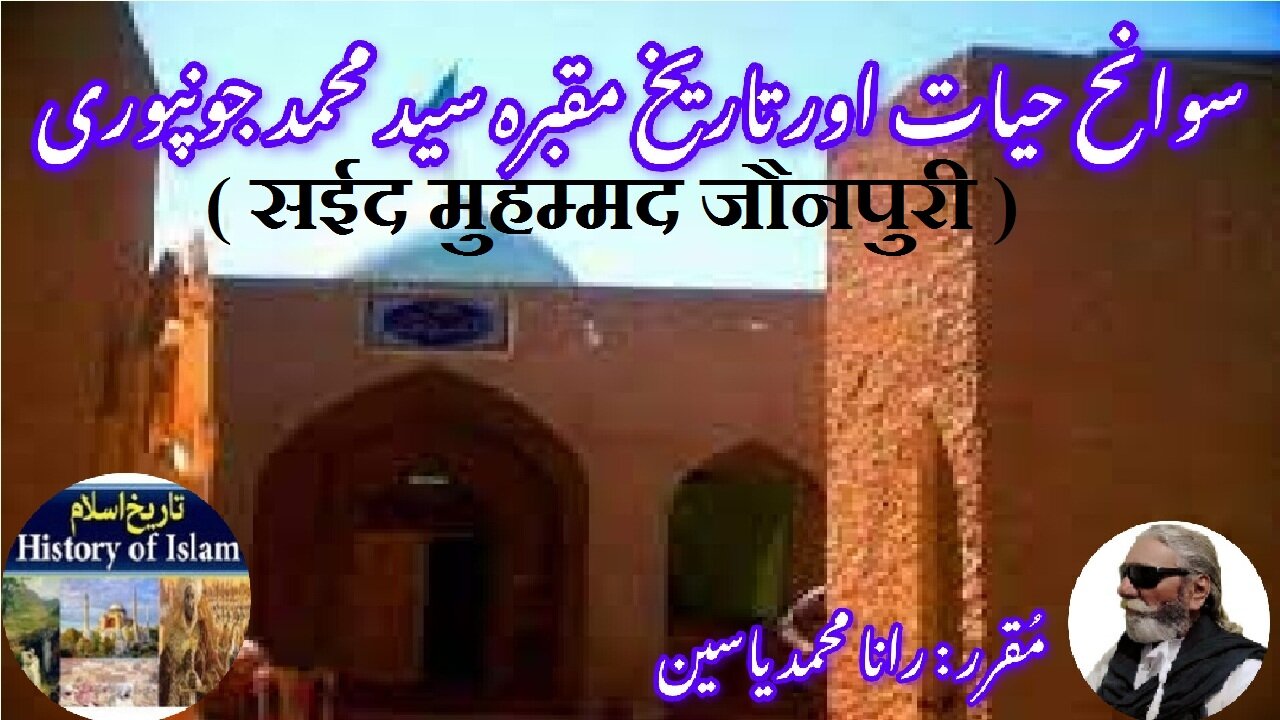Premium Only Content

Sayid Muhammad Jaunpuri सईद मुहम्मद जौनपुरी سید محمد جونپوری کی سیرت اور ان کے مزار کی تاریخ
@islamichistory813 #sufisaint #sayyid #muhammad #jaunpuri #culturalheritage #biography #islamicmysticism #islamicphilosophy #shrine #historicalfigures
Biography of Sayyid Muhammad Jaunpuri and the history of his shrine
Dekhti Aankhooon aur sountay kaanoon ko Asslamoalaikum, sisters, brothers friends and elders, in informative series videos of Islamic ascolars, sufisaints, cultural heritages, islamic philosophys, islamic mysticisms and historical figures. today we are describing biography of Sayyid Muhammad Jaunpuri and the history of his shrine.
Sayyid Muhammad Jaunpuri was an Indian religious leader and the founder of the Mahdavia movement. He claimed to have been divinely appointed as the promised Mahd?, in fulfillment of the Islamic prophecies regarding the end times. Hailing from Jaunpur, he traveled extensively throughout India, Arabia and Khorasan.
His first wife, Bibi Alahdadi, was the daughter of his uncle, Syed Jalaluddin. He married her in Jaunpur in 866H, when he was nineteen years old. Jaunpuri and Alhadadi had two sons and two daughters together, Syed Mahmood Thani-e-Mahdi, Syed Ajmal, Syeda Khunza and Syeda Fatima.
He left Jaunpur along with his family and a group of followers. Migrating from place to place and gathering companions, that would later become the core of the Mahdavia sect founded by him, until he reached Farah in Afghanistan.
By the age of 53 he embarked on the Hajj pilgrimage to Mecca, where in 1496 (901 Hijri), after circumambulating the Kaaba, he declared that he was the Promised Mahdi and whoever believes in him is a Momin.
After staying in Mecca for nearly seven or nine months,[2] he returned to India where he proclaimed himself Mahdi at Ahmedabad and later at Badhli (near Patan, Gujarat)
In 1497, Syed Muhammad Jaunpuri of India claimed to be a reformer with the mission to purify Islam by justifying his claim according to the teachings and sayings of the Prophet of Islam. He started by curbing the innovations, focusing on belief in Allah, offering prayers, search for God and the truth, and also challenging the religious scholars of his time. Thus, he was criticized by religious scholars by refuting Jaunpuri’s claim of being a reformer, interestingly, academicians have also ignored Jaunpuri’s role as a reformer, but this paper discusses the life of Jaunpuri by focusing on his role as a reformer in India, moreover, this paper limits its scope with the life of Jaunpuri as a reformer. The research used a descriptive cum analytical approach which was aimed at making the research a qualitative one and for that various libraries of Pakistan and personal collections of followers of Jaunpuri were accessed, and at the same time, various websites were also surveyed. So, the research resolved that Jaunpuri was a reformer of the 15th century India who did his best to reform the people and society of his time by bringing them closer to their Creator.
Saiyyid Mohammad never claimed that he propounded a new religion, rather he laid emphasis on restoring Islam to it purity. For him, purity means the Islam which was present during the life time of Prophet Mohammad (PBUH). His movement was never meant to get political power or to achieve any fame. He never claimed to belong to any one of school of thought; rather he claimed to have followed the religion of Muhammad (PBUH), and the teachings and practices of the Holy Quran. The Mahdavi Movement gained much popularity in Sindh, Thatta, and Qandhar in Afghanistan. Many rulers, nobles and ulama joined the Mahdavi faith. Few among them were Malik Usman Khan of Jalor, Mirza Baig Arghun of Qandhar, Shaykh Sadruddin of Sindh, Mirza Shaheen of Bhakkar and Qazi Qadan.
Saiyyid Mohammad had declared himself as Mahdi, so his followers were called Mahdavi, and the mission carried out by him and his followers to spread his teachings was named as Mahdavi Movement. Saiyyid Mohammad declared non-Mahdavis as non-Muslims. He declared that non-Mahdawis were like harabis/enemies of Islam, and the jizya/poll tax could therefore be levied upon them, but since it was not the prime object of his mission, so he did not realize it.23 The Mahdavis were not allowed to settle anywhere permanently, and so they had to live a life of wanderer and to spread the message of the Mahdi.
Saiyyid Mohammad spent his life in remote areas living in mosques. The place where the Mahdavis used to stay for a short time is called daira or daera. Literally, daira means circle or to sit while forming or being in a circle. For them, basically dairas were an assembly of Mahdavis which were meant to form a classless community based on egalitarianism in terms of religion. It teaches the Mahdavis to live with each other like kith and kin. These dairas are not only consisting of men but also of women.
In dairas, the Mahdavis used to gather once in a week and confess their sins which they have committed. In extreme cases those who are found guilty are punished according to the laws of shariah. Zikr/Remembering God is one of the foremost duties of Mahdavis in daira. No one is allowed to carry out any work during the zikr. “Members of daira were strictly forbidden to marry the daughters of the new followers unless their sincerity had been tested for one year. The older members were permitted to marry.”
With this, we seek your permission until tomorrow, tomorrow we will describe the biography of Al-Imam Muhammad Ibn Sulayman al-Jazuli and the history of his Shrine. Allah Hafiz.
==================
-
 1:19
1:19
ISLAMIC HISTORY
2 days agoPrayer to see moon Eid al-Fitr, Tomorrow is in Pakistn, چاند دیکھنے کی دعا کل عید الفطر ہے
8 -
 11:40
11:40
Shea Whitney
16 hours ago $4.48 earned20 Best *DESIGNER INSPIRED* Items on Amazon!
34K4 -
 11:05
11:05
Hannah Barron
23 hours agoFirst STEELHEAD Trip!
35.6K13 -
 1:00:13
1:00:13
Trumpet Daily
22 hours ago $7.42 earnedThe World Realigns Against America - Trumpet Daily | Mar. 31, 2025
39.5K24 -
 11:08
11:08
This Southern Girl Can
14 hours agoDIY Spring Wreath
39.4K3 -
 3:04:40
3:04:40
Danny Polishchuk
20 hours agoLiberation Day Looms + Guest Richard Syrett Talks JFK Files | Low Value Mail Live Call In Show
82.4K28 -
 2:40:15
2:40:15
Barry Cunningham
13 hours agoPRESIDENT TRUMP SIGNS NEW EXECUTIVE ORDERS AND THE EVENING NEWS!
79K63 -
 2:49:55
2:49:55
TimcastIRL
13 hours agoGOP Office TORCHED, Terror Suspected, Elon Says ARREST Dem Funders w/Winston Marshall | Timcast IRL
272K126 -
 1:39:42
1:39:42
Glenn Greenwald
16 hours agoMajor Escalation in Attempts to Purge U.S. Universities of Israel Critics; Who are the Israel Groups Providing Lists to the U.S. Government to Deport & Punish? | SYSTEM UPDATE #431
235K217 -
 9:21:30
9:21:30
SpartanTheDogg
19 hours agoPro Halo Player
86.6K4